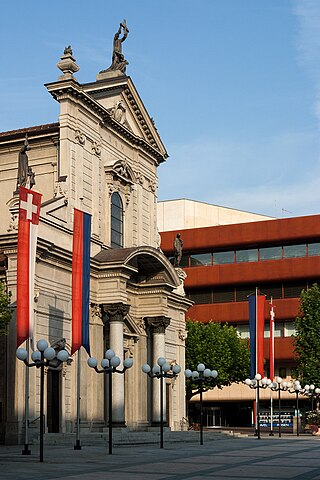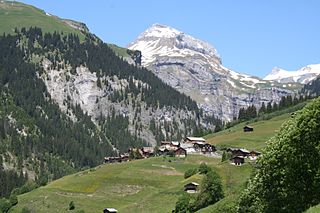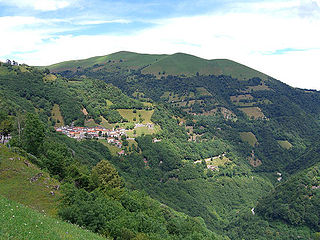
There are 106 municipalities in the canton of Ticino, Switzerland,. Municipalities (comuni) are grouped in circles (circoli) which are part of districts (distretti).

Chiasso is a municipality in the district of Mendrisio in the canton of Ticino in Switzerland.

Zernez is a village and a municipality in the Engiadina Bassa/Val Müstair Region in the Swiss canton of Graubünden. On 1 January 2015 the former municipalities of Lavin and Susch merged into the municipality of Zernez.

Aadorf is a municipality in the district of Münchwilen in the canton of Thurgau in Switzerland. In 1996 Ettenhausen, Guntershausen bei Aadorf, and Wittenwil merged into Aadorf.

Braunau is a municipality in the district of Münchwilen in the canton of Thurgau in Switzerland.

Münchwilen is a municipality and district capital of the district of Münchwilen in the canton of Thurgau in Switzerland.
The Mendrisio District is the southernmost district of canton of Ticino and of Switzerland. To its north lies the Lugano District. It is surrounded on the other three sides by Italy: to the east and south by the province of Como, and to the west by the province of Varese. It has a population of 49,969.
Morbio Superiore was a municipality in the canton of Ticino in Switzerland in the hills above Chiasso. It is located in the district of Mendrisio. On 25 October 2009 the municipalities of Bruzella, Cabbio, Caneggio, Morbio Superiore, Muggio and Sagno merged into the municipality of Breggia.
Muggio was a municipality in the district of Mendrisio in the canton of Ticino in Switzerland. On 25 October 2009 the municipalities of Bruzella, Cabbio, Caneggio, Morbio Superiore, Muggio and Sagno merged into the municipality of Breggia.
Cabbio was a municipality in the district of Mendrisio in the canton of Ticino in Switzerland. On 25 October 2009. the municipalities of Bruzella, Cabbio, Caneggio, Morbio Superiore, Muggio, Sagno, and Breggia merged into the municipality of Breggia
Bruzella was a municipality in the district of Mendrisio in the canton of Ticino in Switzerland. On 25 October 2009 the municipalities of Bruzella, Cabbio, Caneggio, Morbio Superiore, Muggio and Sagno merged into the municipality of Breggia.
Caneggio is a former municipality in the district of Mendrisio in the canton of Ticino in Switzerland. On 25 October 2009 the municipalities of Bruzella, Cabbio, Caneggio, Morbio Superiore, Muggio, and Sagno merged into the municipality of Breggia
Sagno is a former municipality in the district of Mendrisio in the canton of Ticino in Switzerland; it is now part of the new municipality of Breggia. On 25 October 2009 the municipalities of Bruzella, Cabbio, Caneggio, Morbio Superiore, Muggio, Sagno merged into Breggia.

Alto Malcantone is a municipality in the district of Lugano in the canton of Ticino in Switzerland. It was formed on 13 March 2005 from the earlier municipalities of Arosio, Breno, Fescoggia, Mugena and Vezio.

Vella is a village and a former municipality in the district of Surselva in the canton of Graubünden in Switzerland. The municipalities of Cumbel, Degen, Lumbrein, Morissen, Suraua, Vignogn, Vella, and Vrin merged on 1 January 2013 into the new municipality of Lumnezia.

Pigniu is a former municipality in the district of Surselva in the canton of Graubünden in Switzerland. Its official language is Romansh. On 1 January 2014 the former municipalities of Pigniu, Castrisch, Ilanz, Ladir, Luven, Pitasch, Riein, Ruschein, Schnaus, Sevgein, Duvin, Rueun and Siat merged into the new municipality of Ilanz/Glion.

Gambarogno is a municipality in the district of Locarno in the canton of Ticino in Switzerland. It was created on 25 April 2010 through the merger of the municipalities of Caviano, Contone, Gerra, Indemini, Magadino, Piazzogna, San Nazzaro, Sant'Abbondio and Vira.

The Valle di Muggio is situated in Ticino in Switzerland and is the southernmost valley of the country.

Monteceneri is a municipality in the district of Lugano in the canton of Ticino in Switzerland. It was created on 21 November 2010 through the merger of the municipalities of Medeglia, Bironico, Camignolo, Rivera and Sigirino. The first mayor elected was Emilio Filippini, who held the position until 2016.1

Tresa is a municipality in the district of Lugano in the canton of Ticino in Switzerland. It was created on 18 April 2021 through the merger of Croglio, Monteggio, Ponte Tresa and Sessa.




















